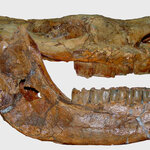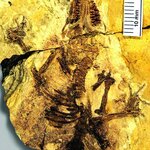Paleontology
Mention "Mass Extinction" and most people will immediately think of the extinction that killed the dinosaurs.
To be fair, this was pretty big, as far as extinctions go. Not only did it kill all of the non-avian dinosaurs, it also finished off the ammonites, belemnites, all of the large swimming reptiles, and many, many others. It's almost like all mammals being killed today.
So yes, pretty big. The K-T extinction, as it's called, ranks among the top 5 greatest extinctions in Earth's paleozoic history.
But it's peanuts to the P-T extinction.
To put it in perspective, at the K-T extinction,…

A giant crococile versus a giant snake in a Colombian coal mine? It sounds even more awesome than "Mega Shark Versus Giant Octopus", except the real life version does not have Debbie Gibson.
An ancient crocodile relative, a dyrosaurid now named Acherontisuchus guajiraensis, likely gave the world's largest snake a tussle or two. In Palaeontology, University of Florida researchers describe the new 20-foot extinct species which was discovered in the same Colombian coal mine as Titanoboa cerrejonensis, the world's largest snake.
Since Acherontisuchus was a freshwater, coastal reptile, it…

In 1997, Ray Stanford, a citizen scientist dinosaur tracker who often spent time looking for fossils close to his Maryland home, was searching a creek bed after an extensive flood and discovered a fossil which he identified as a nodosaur.
Nodosaurs have been found in diverse locations worldwide, but they've rarely been found in the United States. The area had originally been a flood plain, where the dinosaur originally drowned and it was tiny - only 13 cm long, just shorter than the length of a dollar bill. Adult nodosaurs are estimated to have been 20 to 30 feet long.…

Brain, pelvis, hands and feet don't lie - and five recent studies of Australopithecus sediba, a primitive hominin that existed around the same time early Homo species first began to appear on Earth, suggest this ancient relative and its primitive and modern, human-like traits, make it the best candidate for an ancestor to the Homo genus.The discoveries are casting doubt on some long-standing theories about human evolution, including the notion that early human pelvises evolved in response to larger brain sizes. And there is also some new evidence suggesting that …

A new oldest woolly rhino fossil in Tibet suggests some giant mammals evolved there before the beginning of the Ice Age, but it leaves a lot of questions about where these giants came from and how they acquired their adaptations for life in a cold environment.
A team of geologists and paleontologists led by Xiaoming Wang from the Natural History Museum of Los Angeles County (NHM) and Qiang Li of Institute of Vertebrate Paleontology and Paleoanthropology, Chinese Academy of Sciences, uncovered a complete skull and lower jaw of a new species of woolly rhino (Coelodonta thibetana) in the…

A fossil discovered in northeast China has pushed back mammal evolution 35 million years and provides new information about the earliest ancestors of most of today's mammal species—the placental mammals.
A team of scientists led by Carnegie Museum of Natural History paleontologist Zhe-Xi Luo describes in Nature Juramaia sinensis, a small shrew-like mammal that lived in China 160 million years ago during the Jurassic period. Juramaia is the earliest known fossil of eutherians, the group that evolved to include all placental mammals, which provide nourishment to unborn young via a…

When nails appeared on all fingers and toes in modern primates about 55 million years ago, they led to the development of critical functions, including finger pads that allow for sensitive touch and the ability to grasp.
In a new study of Teilhardina brandti,
an extinct primate originally described from a single lower molar, researchers recovered and analyzed the oldest fossil evidence of fingernails in modern primates, confirming the idea nails developed with small body size and disproving previous theories nails evolved with an increase in primate body size.
More than 25 new specimens of…

It's not often that paleontology makes the news. This week, however, it did - in a big way. And let me tell you, it wasn't the edgy paper on a new assemblage of South American bivalves ("Barremian Bivalves from the Huitrín Formation, West-Central Argentina: Taxonomy and Paleoecology of a Restricted Marine Association") that was all over the rolling news channels.
No; it's the news that Archaeopteryx may be knocked off its pedestal as the earliest bird in the fossil record, based on a new phylogeny by Xu et al. Archaeopteryx is now deemed to be just another deinonychosaur; probably closer to…

Metasequoia, a deciduous conifer, and one of the common fossils found in many of the Eocene sites of the Pacific northwest, flourished in Oregon's forests for millions of years. In honor of this long history, Oregon has named it their official state fossil.
Metasequoia were first described from the Mesozoic from Shigeru Miki in 1941. Miki, thinking they were long extinct was surprised that his 'fossil first' had living relatives. The "dawn redwood" was rediscovered in China in 1941 in Modaoxi. The excitement of the find was diminished by the heating up of World War II. In 1948, Wan…